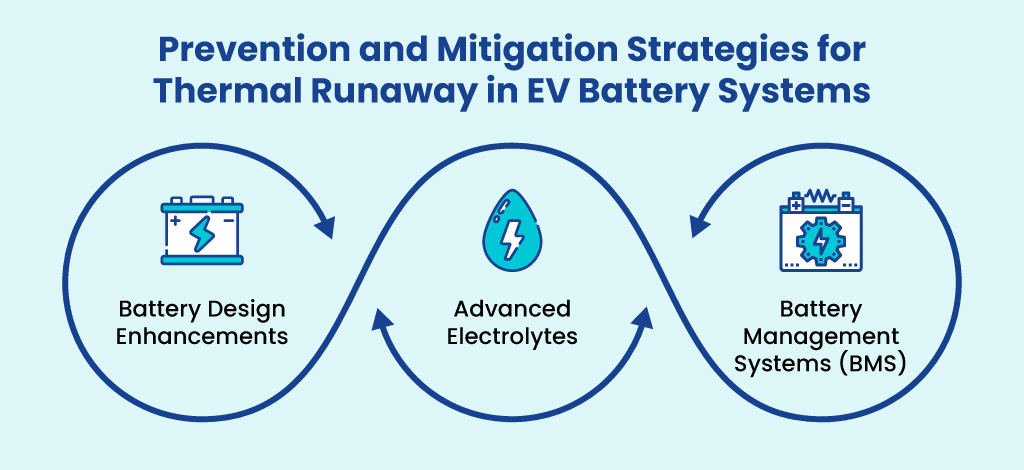Electric Vehicle (EV) battery thermal runaway is a rare yet dangerous phenomenon. This happens when the battery’s temperature rises out of control, which can lead to serious accidents.
Incidents, such as the electric van fire involving a Mercedes Vito EV in June 2023, highlight the real-world consequences of thermal runaway.
Key factors behind this incident could be overcharging, short circuits, or manufacturing defects. The risk of EV battery thermal runaway has resulted in plenty of research in this area. Understanding and mitigating these risks is paramount, with a focus on advanced sensor technologies, improved materials, and robust Battery Management Systems (BMS).
In this blog post, we explore how to address thermal runaway for the widespread adoption of EVs.
Factors Leading to Thermal Runaway
Thermal runaway in lithium-ion batteries is generally triggered by issues like
- A short circuit that can cause rapid electrical current surges, leading to overheating and uncontrolled chemical reactions.
- Overcharging, which induces excessive heat during the charging process, risking battery breakdown.
- Manufacturing defects may compromise structural integrity and thermal stability, increasing the chances of thermal runaway and hazardous gas release.
Warning Signs of Thermal Runaway
- Heightened temperatures within the battery pack signal potential thermal runaway, demanding vigilant temperature monitoring for early detection.
- Irregular voltage fluctuations, monitored by Advanced Battery Management Systems (BMS), are early indicators. Sudden spikes or drops indicate instability, prompting interventions to prevent escalation.
- Gas sensors detect and quantify emissions, notably hydrogen, during thermal runaway. A sudden increase in gas levels signals an imminent event, necessitating immediate action to mitigate risks.
Identifying Risk Factors and Warning Signs in Thermal Runaway
Judging by its critical damages, the early detection of thermal runaway is pivotal in upholding the safety and reliability of electric vehicle (EV) battery systems.
Here are some of the most prevalent early detection systems:
1. Sensor Technologies
The advanced sensors intricately integrated into the battery system measure parameters like temperature, voltage, current, and gas emissions.
2. IoT Integration
The seamless integration of IoT technologies fosters continuous communication between the battery system and external monitoring platforms. This connectivity empowers remote monitoring and real-time analysis of critical parameters, facilitating swift responses to emerging issues.
The Role of IOT & AI in Battery Management of Electric Vehicle, 2023 by Kavita Kumari. K.S, L. Chitra, J. M. Abraham, N. Joseph and Y. K. T.K. International Conference on Signal Processing, Computation, Electronics, Power and Telecommunication (IConSCEPT), Karaikal, India, 2023, pp. 1-7, doi: 10.1109/IConSCEPT57958.2023.10170275.]
3. Infrared Cameras
Recent research introduces infrared cameras as a non-invasive/non-destructive method for detecting abnormal heat patterns within EV battery systems. This innovative approach adds an extra layer of fail-safe to address potential risks preemptively.
Prevention and Mitigation Strategies for Thermal Runaway in EV Battery Systems

Here are some vital strategies to mitigate EV battery thermal runaway and enhance battery performance:
1. Battery Design Enhancements
Preventing thermal runaway initiates with meticulous battery design, incorporating features that prioritize safety.
Thermal barriers, integrated into the battery structure, act as physical layers to impede heat spread in case of malfunctions.
These barriers, serving as insulation, mitigate the risk of thermal runaway propagation. Improved separators in lithium-ion batteries help keep temperatures stable and prevent internal short circuits, which often cause thermal runaway.
2. Advanced Electrolytes
Critical to the prevention strategy are advanced electrolytes with heightened thermal stability. Researchers are exploring formulations resistant to elevated temperatures, preventing exothermic reactions that could trigger thermal runaway. This innovation enhances the overall resilience of the battery system.
3. Battery Management Systems (BMS)
Central to thermal runaway prevention is the implementation of sophisticated Battery Management Systems (BMS). Serving as the battery’s ‘central nervous system,’ BMS continuously monitors and controls parameters to ensure safe operation. It plays a crucial role, for example:
- Temperature Monitoring: Strategically placed temperature sensors within the battery pack allow the BMS to detect abnormal temperature increases—a crucial precursor to thermal runaway.
- Voltage and Current Control: Closely monitoring voltage and current helps the BMS identify deviations from normal conditions, signaling potential issues and prompting corrective actions.
- Early Intervention Measures: BMS can implement early intervention measures in response to detected instability, dynamically adjusting charging rates or isolating specific cells showing signs of instability.
- Containment Mechanisms: In large-scale EV battery packs, containing thermal runaway is crucial. Containment mechanisms isolate affected cells, preventing widespread damage.
- Fire-Resistant Materials: Equipping battery packs with fire-resistant materials serves as a barrier, withstanding high temperatures and containing potential fire outbreaks.
- Isolation Systems: Advanced isolation systems, including thermal barriers and physical separators, contain thermal runaway events to ensure failures in one part do not compromise the entire pack.
- Ventilation and Cooling: Ventilation systems and active cooling mechanisms, like liquid cooling or dedicated fans, dissipate heat, reducing the risk of thermal runaway and maintaining optimal operating temperatures.
Current Research Areas in Thermal Runaway Prevention for EV Battery Systems
These ongoing research contributions help in advancing thermal runaway prevention strategies and enhancing the safety of EV battery systems:
1. Advanced Electrolytes
Recent research is exploring better electrolytes to make lithium-ion batteries more temperature-stable. By improving these formulas, researchers hope to create electrolytes that handle tough conditions better, lowering the chances of thermal runaway.
- Highly Stable Ionic Liquids: Exploring ionic liquids with superior thermal stability as an alternative to conventional electrolytes is a promising avenue. These liquids have the potential to endure higher temperatures without triggering exothermic reactions, contributing to the overall safety of the battery system.
- Solid-State Electrolytes: Investigating solid-state electrolytes in solid or gel form represents a noteworthy advancement. These materials offer improved thermal stability and eliminate the flammability of liquid electrolytes, significantly reducing the risk of thermal runaway. One of the notable leaders in this area is Toyota.
Toyota’s solid-state batteries use sulfide-based electrolytes that offer higher performance at low temperatures. [Source]
2. Improved Separators
The separator, a vital component in lithium-ion batteries preventing short circuits, is under continuous research for enhancements that make it more resistant to thermal stress and mechanical abuse.
- Advanced Polymer Separators: Exploration of advanced polymer-based separators with increased thermal stability is underway. These polymers can better endure elevated temperatures, minimizing the probability of thermal runaway events caused by separator failure.
- Nanocomposite Separators: Investigating nanocomposite materials, combining polymers with nanoscale additives, holds promise for improving thermal and mechanical properties. These materials contribute to the overall safety and performance of lithium-ion batteries by mitigating the impact of thermal stress.
3. Battery Formulations with Increased Resilience
Beyond electrolytes and separators, researchers are dedicated to refining the overall battery formulation to enhance resistance against thermal runaway.
- Enhanced Cathode and Anode Materials: Advancements in cathode and anode materials focus on improving their thermal stability. Modifications to the chemical composition and structure aim to reduce the likelihood of exothermic reactions leading to thermal runaway.
4. Mathematical Modeling for Prediction and Understanding
Mathematical models play a vital role in predicting and understanding the intricate behaviors associated with thermal runaway, leveraging computational simulations.
- Thermal Runaway Predictive Models: Sophisticated mathematical models consider multiple parameters, including temperature, pressure, and chemical reactions within the battery. These models aim to predict thermal runaway events before they occur, offering insights for the design and optimization of safer batteries.
Exicom has leveraged COSMOL simulation models for accurate BMS to ensure safer and higher-performing battery packs. [Source]
5. Novel Materials and Technologies for Thermal Management
Efficient thermal management is pivotal in preventing thermal runaway, leading researchers to explore novel materials and technologies.
- Phase Change Materials (PCMs): Investigating PCMs capable of absorbing and releasing heat during phase transitions is underway for effective thermal management. Incorporating PCMs into battery design helps regulate temperature, reducing the risk of thermal runaway.
Rogers Corporation has expanded its HeatSORB phase-change materials that optimise the temperature during usage by capturing the heat. [Source] - Advanced Cooling Systems: The study of innovative cooling systems, including microchannel coolants and thermal interface materials, aims to enhance overall heat dissipation efficiency in EV battery packs. These technologies work toward maintaining optimal operating temperatures, minimizing the likelihood of thermal runaway.
Safeguarding the Future of EVs
As electric vehicles (EVs) become more popular, it’s important for manufacturers to focus on preventing EV battery thermal runaway. To manage these risks, a complete approach is needed that includes good design, early detection, and ways to control problems.
Continued research and new technologies promise to make EVs safer and more dependable. Working together across different fields of study is key to making EVs widely used without sacrificing safety.
At this site, we unlock discreet technical knowledge within patents, aiding researchers in faster R&D breakthroughs. With an extensive repository, we distill patent information into straightforward English summaries, facilitating problem-solving, uncovering inventive perspectives, and reinforcing research strategies.
Explore Patents, Explore Possibilities. Feel free to explore more!!
